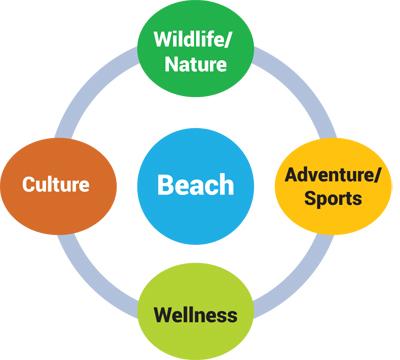Reply To:
Name - Reply Comment
The last few months have seen tourism booming in Sri Lanka, with almost all hotels brimming with high occupancy. Although everything seems to be progressing well, over the years, Sri Lanka tourism has been searching for its proper positioning in the international market.
Lanka tourism has been searching for its proper positioning in the international market.
We have dabbled with various configurations, permutations and combinations but yet we still lack a clear understanding of Sri Lanka tourism’s true brand promise. Is it the beach? Is it wildlife? Is it culture? What types of tourists are we aiming to attract? High-end or low-end?
This article attempts to shed some light on this confusion.
Positioning and branding
In a rapidly changing, volatile and competitive tourism market environment, a destination has to correctly position itself to ‘stand out and be noticed’. To help develop a positioning platform, firstly, the destination must be clear about what its unique selling proposition (USP) is.
What is it in Sri Lanka that stands out and appeals to customers? How is it unique? How does it differentiate from the myriad of other offerings in the market?
From this positioning, follows the branding process. It involves creating a strong, positive perception of its products or services in the customer’s mind. This process combines elements such as a logo, design, tagline and a consistent theme throughout all marketing communications.
In their excellent 1981 book, ‘Positioning: The Battle for your Mind’, Al Ries and Jack Trout describe how positioning is used as a communication tool to reach target customers in a crowded marketplace.
Therefore, to ‘get into the prospect’s mind’, it is vital that the brand must be correctly ‘positioned’ to relate to the prospect. Prospects don’t buy—they choose. What matters is the position relative to other choices and being trusted.
Unique selling proposition
The USP will obviously be different for different market segments. So, before we decide on our USP and positioning, we have to decide which customer segment we are targeting. Tourism Australia has different marketing strategies for different source markets. For example, the advertising in the Indian market – shopping and sightseeing, is quite different to that of the UK –
food and wine).
Sri Lanka seems to be confused about what its real USP is. This could be perhaps because we have so much to offer, that it is difficult to choose. Certainly, Sri Lanka is blessed with a plethora of natural assets and a rich culture and heritage. Hence, identifying a ‘hard’ product-based USP may be difficult and perhaps we should lean towards a more emotional one.
High-end or low-end?
This is where the confusion begins. On the one hand, our leaders talk about targeting an average spend per tourist night of about US $ 500 to US $ 750. In the same breath, they cheer the rapidly increasing tourist arrivals and aim to target over 10 million tourists in the next few years.
rapidly increasing tourist arrivals and aim to target over 10 million tourists in the next few years.
Larger numbers generally mean more low-spending tourists. After all, economies of scale are universal and apply to the tourism industry as well. Higher-spending tourists would therefore, be fewer in numbers but they would seek a more bespoke, wholesome, high-quality product and service with greater experiential value.
Certainly, servicing the mass market is much easier—herding tourists en masse into large buses, following familiar excursion routes and offering large, uninteresting buffet meals, etc. On the other hand, servicing a more discerning high-end tourist is much more demanding and requires more effort and resources. But the returns are high: ‘No pain, no gain’.
So, what do we want? Millions of tourists swarming all over our attractions, overcrowding them and causing environmental damage? Are we serious about sustainability? Can a small, overpopulated island of 65,000 sq. km cope with an influx of millions of tourists? Or do we want a lesser number of more discerning tourists, who would take their time to explore the destination in an environmentally sustainable manner and have a richer experience?
Certainly, there is a marked drop in service quality seen in hotels now. Rising costs and servicing debts are serious issues. Many older hotels are aging and require refurbishing. So, perhaps it is due to these limitations of financial resources and infrastructure that the path of ‘quantity over quality’ has been preferred over time.
Of course, there are a few high-end properties in Sri Lanka today, commanding rates of US $ 1,000 per night. As of 2023, there were only 41 high-end boutique accommodation units, with 855 rooms (only 2.3 percent of the total room inventory in 2023). There were 386 larger conventional hotels, accounting for 25,082 rooms (47 percent of the total room inventory in 2023).
So, Sri Lanka tourism seems to be stuck in a quagmire. We seem to be in the middle, wanting a ‘little bit of everything’.
Mix and match? Thailand
This is not to say that a healthy mix of high-end and low-end does not work. Thailand is a case in point. It has elegant upmarket hotels, while at the same time, there is a healthy small and medium sector that also thrives. Thailand is set to attract some 34+ million tourists this year.
The main prerequisites are a good infrastructure that can handle such large numbers, low operational costs, excellent quality of hotels (big and small) and of course, geographical size (which Thailand does have with attractions spread all over the country). This has to be supported by appropriate branding and messaging.
The pristine blue beaches, coral islands, mountains, shopping malls and markets, temples, monasteries and of course, the exotic never-ending nightlife of Thailand have been successfully captured in the brand campaign ‘Amazing Thailand’. It appeals across the board to a wide segment of travellers, not necessarily targeting specifically high or low-end.
“Meaningful relationships are an integral part of our latest communication campaign, designed to ignite wanderlust in globetrotters worldwide,” said TAT Deputy Governor for Marketing Communications Thailand
Nithee Seeprae.
“We want every traveller to indulge in meaningful connections with every aspect of Thailand, be it the locals, communities, nature or unforgettable, one-of-a-kind experiences.”
So, wither Sri Lanka?
We have dabbled with taglines, which have been changed according to the whims and fancies of the governing bodies at different stages. Some of the taglines we have had in the recent past are:
The plethora of taglines that were developed and changed so rapidly, only confirms the fact that we have not got our positioning right, as mentioned earlier.
We need to go back to the basics. Firstly, there must be some good consumer research done in all our source markets. After that, all stakeholders must get together and deliberate, analyse and debate to reach a consensus on Sri Lanka’s proper USP, based on consumer perception. It is not what matters to us but what matters to the consumer. Only after that should we embark on a proper marketing strategy, branding and a tagline.
Many years ago, we did an exercise along these lines (the first and only such effort I know of) under the chairmanship of Renton de Alwis, where we got together, armed with some extensive research done by A.C. Nielsen and facilitated by SLIM past President
Wille Weerasekara.
The findings indicated that our beaches were still the prime ‘top-of-the-mind-recall’ for most consumers but that there were certain other offerings that also stood out. From this, we developed the model (See graphic) for our product offering.
This clearly identified that our beaches are a very important component of our product offering but it was augmented by adventure, wellness, wildlife and culture. (Unlike the Maldives, which focuses solely on beaches).
Our positioning statement was to be: ‘The World’s Finest Island for Diverse, Authentic and Memorable Experiences’.
Each of the key words have great significance.
In my view, this was the closest we came to properly capturing the essence of Sri Lanka in an effective positioning strategy for marketing the country internationally.
Alas, like so many good initiatives, this too was delegated to the dustbin, after a regime change.
(Srilal Miththapala acknowledges the help given by Dewni Aluthwatte in the preparation of this monograph)